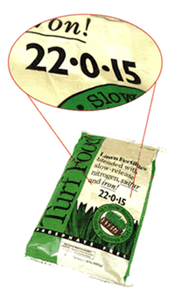Minnesota’s Phosphorus Lawn Fertilizer Law was enacted to reduce over-enrichment of rivers, lakes, and wetlands with the nutrient phosphorus. Excessive phosphorus in surface water leads to an overabundance of algae and other aquatic plants.
The law was enacted over a period of years starting in 2002. Restriction on phosphorus fertilizer use on lawns and turf started in 2004 in the seven-county Twin Cities metro area and in Minnesota’s other 80 counties in 2005. Minnesota was the first state in the nation to regulate phosphorus fertilizer use on lawns and turf. As of 2012, ten other states have similar laws.
Full text of the law is found in Minnesota’s Fertilizer, Soil Amendment, and Plant Amendment Law, Chapter 18C of the Minnesota State Statutes.
Use of Phosphorus Fertilizer on Lawns and Turf is Restricted
Fertilizers containing phosphorus cannot be used on lawns and turf in Minnesota unless one of the following situations exists:
- A soil test or plant tissue test shows a need for phosphorus.
- A new lawn is being established by seeding or laying sod.
- Phosphorus fertilizer is being applied on a golf course by trained staff.
- Phosphorus fertilizer is being applied on farms growing sod for sale.
When these situations do not exist, state law requires phosphorus-free lawn fertilizer is to be used. The nutrient value of a fertilizer is indicated by a series of three numbers printed on its container. The numbers represent percent nutrient content of nitrogen, phosphorous, and potassium, in that order. A fertilizer marked with 22-0-15, for example, is phosphorus-free as the middle number is zero. Zero is defined to be less than 0.67% phosphate.
When used, phosphorus lawn fertilizer needs to be applied at rates recommended by the University of Minnesota and approved by the Minnesota Department of Agriculture. These rates are based on soil test results and can be found on the University of Minnesota Extension website

Fertilizer on Paved Surfaces Needs to be Cleaned Up
Fertilizer spilled or spread on paved surfaces such as sidewalks, driveways, and streets needs to be cleaned up immediately to prevent it from washing away into rivers, lakes and wetlands. This applies to all fertilizers, whether or not they contain phosphorus or not. (Minn. Stat. 18C.61)
Enforcement
Restrictions and prohibitions in this law are enforced by local units of government under their existing authority. Violations are treated as petty misdemeanors. (Minn. Stat. 18C.62)
Preemption of Local Law
Local units of government may not adopt or enforce ordinances regulating the sale, handling, use or disposal of phosphorus lawn fertilizers. Exceptions to this are local ordinances regulating the sale (not use) of phosphorus lawn fertilizer which were in effect on August 1, 2002. (Minn. Stat. 18C.110)
Local units of government may not prohibit or regulate the sale, handling or use of phosphorous fertilizers for agricultural use (growing of crops including sod farms).
Consumer Information (Minn. Stat. 18C.60)
Consumer information needs to be provided by the Minnesota Department of Agriculture in consultation with the University of Minnesota, fertilizer industry, lakes groups, and others.
Research Evaluation and Reporting
Evaluation of research needs to be done by the Minnesota Department of Agriculture cooperation with the University of Minnesota and in consultation with fertilizer industry, lakes groups, and others. A report on the effectiveness of the phosphorus law was submitted to the legislature in 2007. (Minn. Stat. 18C.60)
Definition of 0% Phosphate
Minnesota Rule 1510.0420 sets the "investigational allowance" for the analysis of phosphorus fertilizers at 0.67% phosphate (analysis of phosphorus fertilizer is given in terms of phosphate, P2O5). Minnesota Statutes 18C.211 requires nutrient analysis of specialty fertilizers (which includes lawn fertilizer) not to exceed or be below this amount. Therefore to be labeled 0% phosphate, a lawn fertilizer cannot contain more than 0.67% phosphate by weight.
Definition of "Local Unit of Government"
"Local unit of government" means a statutory or home rule charter city, town, county, soil and water conservation district, watershed district, another special purpose district, and local or regional board (Minn. Stat. 18B.01, subd. 14a).

